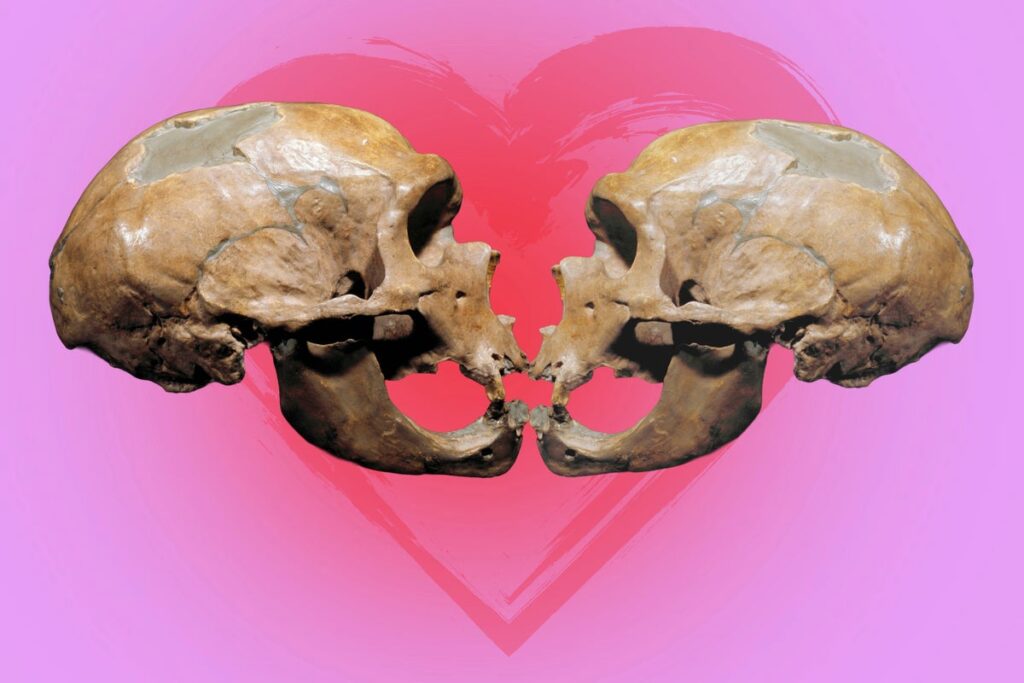November 19, 2025
3 min read
Kissing May Have Evolved 21.5 Million Years Ago
Humans and their ancestors have likely been kissing for a very long time
Photo by Stefano Bianchetti/Getty Images; Illustration by Scientific American
For humans, kissing holds major cultural cachet, accompanying confessions of romantic love, religious rituals of reverence and even betrayals, à la The Godfather Part II’s “kiss of death.”
New research suggests that kissing probably predates humanity and evolved between 16.9 million and 21.5 million years ago, after the ancestor of the great apes split from the lesser apes, or gibbons. There is even evidence that Neandertals kissed.
“Kissing is a really interesting one because it’s something humans seem to take for granted,” says study lead author Matilda Brindle, an evolutionary biologist at the University of Oxford. Surprisingly, romantic kissing has been documented in only 46 percent of human cultures, she says. “But for those who do kiss, it’s this everyday act that also has this huge cultural significance.”
On supporting science journalism
If you’re enjoying this article, consider supporting our award-winning journalism by subscribing. By purchasing a subscription you are helping to ensure the future of impactful stories about the discoveries and ideas shaping our world today.
Brindle and her colleagues, Catherine Talbot of the Florida Institute of Technology and Stuart West of Oxford, wanted to evaluate kissing from an evolutionary perspective. So they searched through past studies for modern examples of primates smooching, defined rather unromantically as “non-agonistic interaction involving directed, intraspecific, oral-oral contact with some movement of the lips/mouthparts and no food transfer.” They found that just like humans, great apes kiss for a variety of reasons, from conveying sexual desire to indicating friendly, affectionate feelings.
“When chimps have an argument,” she says, “they will often go and literally kiss and make up afterwards.”
The researchers also found reports of kissing in all great apes, from humans to chimpanzees to orangutans, with the exception of the eastern gorilla. There were no observations of kissing in gibbons. Based on this taxonomy, the researchers estimate that kissing evolved after the great apes split from the lesser apes. This means that Neandertals and other human ancestors probably kissed. Bolstering this idea, preliminary evidence from DNA in ancient dental plaque has shown that Neandertals and humans shared oral bacteria until 112,000 years ago, hinting that they may have kissed each other.
The primate kissing observations were too fragmented to reveal much about how or why kissing evolved, however. Species that kiss tend to have mating systems in which females mate with multiple males, the researchers report in the new study, which was published in the journal Evolution and Human Behavior. Every species that kisses also engages in premastication, or chewing food before giving it over to another individual, which could be a precursor to kissing, Brindle says. There is a lack of data about premastication in species that don’t kiss, however, making the link tenuous.
It’s also unclear whether both platonic and sexual kissing have the same roots, says Zanna Clay, a comparative psychologist at Durham University in England, who researches primate behavior but was not involved in the study. Kissing during mating is less often observed in the wild than affectionate kissing, Clay says: “This study is working with a relatively limited dataset.”
Primate researchers haven’t focused much on primate kissing, Brindle concurs, saying the paper is a “cry” for researchers to collect more data. “It’s really exciting that we’ve traced the evolutionary history of kissing back to 21.5 million years ago,” she says, “but we could do so much more if we had additional data.”
It’s Time to Stand Up for Science
If you enjoyed this article, I’d like to ask for your support. Scientific American has served as an advocate for science and industry for 180 years, and right now may be the most critical moment in that two-century history.
I’ve been a Scientific American subscriber since I was 12 years old, and it helped shape the way I look at the world. SciAm always educates and delights me, and inspires a sense of awe for our vast, beautiful universe. I hope it does that for you, too.
If you subscribe to Scientific American, you help ensure that our coverage is centered on meaningful research and discovery; that we have the resources to report on the decisions that threaten labs across the U.S.; and that we support both budding and working scientists at a time when the value of science itself too often goes unrecognized.
In return, you get essential news, captivating podcasts, brilliant infographics, can’t-miss newsletters, must-watch videos, challenging games, and the science world’s best writing and reporting. You can even gift someone a subscription.
There has never been a more important time for us to stand up and show why science matters. I hope you’ll support us in that mission.

